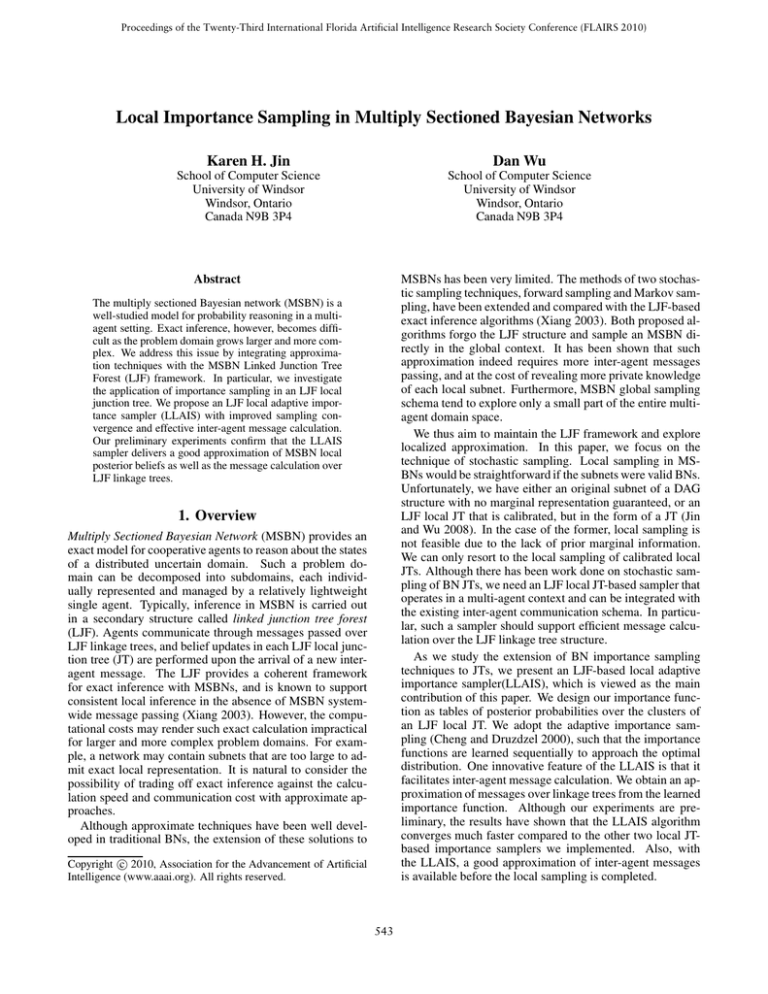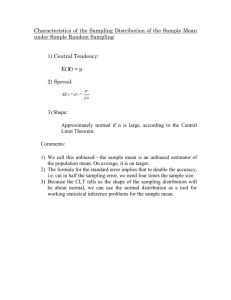
Proceedings of the Twenty-Third International Florida Artificial Intelligence Research Society Conference (FLAIRS 2010)
Local Importance Sampling in Multiply Sectioned Bayesian Networks
Karen H. Jin
Dan Wu
School of Computer Science
University of Windsor
Windsor, Ontario
Canada N9B 3P4
School of Computer Science
University of Windsor
Windsor, Ontario
Canada N9B 3P4
MSBNs has been very limited. The methods of two stochastic sampling techniques, forward sampling and Markov sampling, have been extended and compared with the LJF-based
exact inference algorithms (Xiang 2003). Both proposed algorithms forgo the LJF structure and sample an MSBN directly in the global context. It has been shown that such
approximation indeed requires more inter-agent messages
passing, and at the cost of revealing more private knowledge
of each local subnet. Furthermore, MSBN global sampling
schema tend to explore only a small part of the entire multiagent domain space.
We thus aim to maintain the LJF framework and explore
localized approximation. In this paper, we focus on the
technique of stochastic sampling. Local sampling in MSBNs would be straightforward if the subnets were valid BNs.
Unfortunately, we have either an original subnet of a DAG
structure with no marginal representation guaranteed, or an
LJF local JT that is calibrated, but in the form of a JT (Jin
and Wu 2008). In the case of the former, local sampling is
not feasible due to the lack of prior marginal information.
We can only resort to the local sampling of calibrated local
JTs. Although there has been work done on stochastic sampling of BN JTs, we need an LJF local JT-based sampler that
operates in a multi-agent context and can be integrated with
the existing inter-agent communication schema. In particular, such a sampler should support efficient message calculation over the LJF linkage tree structure.
As we study the extension of BN importance sampling
techniques to JTs, we present an LJF-based local adaptive
importance sampler(LLAIS), which is viewed as the main
contribution of this paper. We design our importance function as tables of posterior probabilities over the clusters of
an LJF local JT. We adopt the adaptive importance sampling (Cheng and Druzdzel 2000), such that the importance
functions are learned sequentially to approach the optimal
distribution. One innovative feature of the LLAIS is that it
facilitates inter-agent message calculation. We obtain an approximation of messages over linkage trees from the learned
importance function. Although our experiments are preliminary, the results have shown that the LLAIS algorithm
converges much faster compared to the other two local JTbased importance samplers we implemented. Also, with
the LLAIS, a good approximation of inter-agent messages
is available before the local sampling is completed.
Abstract
The multiply sectioned Bayesian network (MSBN) is a
well-studied model for probability reasoning in a multiagent setting. Exact inference, however, becomes difficult as the problem domain grows larger and more complex. We address this issue by integrating approximation techniques with the MSBN Linked Junction Tree
Forest (LJF) framework. In particular, we investigate
the application of importance sampling in an LJF local
junction tree. We propose an LJF local adaptive importance sampler (LLAIS) with improved sampling convergence and effective inter-agent message calculation.
Our preliminary experiments confirm that the LLAIS
sampler delivers a good approximation of MSBN local
posterior beliefs as well as the message calculation over
LJF linkage trees.
1. Overview
Multiply Sectioned Bayesian Network (MSBN) provides an
exact model for cooperative agents to reason about the states
of a distributed uncertain domain. Such a problem domain can be decomposed into subdomains, each individually represented and managed by a relatively lightweight
single agent. Typically, inference in MSBN is carried out
in a secondary structure called linked junction tree forest
(LJF). Agents communicate through messages passed over
LJF linkage trees, and belief updates in each LJF local junction tree (JT) are performed upon the arrival of a new interagent message. The LJF provides a coherent framework
for exact inference with MSBNs, and is known to support
consistent local inference in the absence of MSBN systemwide message passing (Xiang 2003). However, the computational costs may render such exact calculation impractical
for larger and more complex problem domains. For example, a network may contain subnets that are too large to admit exact local representation. It is natural to consider the
possibility of trading off exact inference against the calculation speed and communication cost with approximate approaches.
Although approximate techniques have been well developed in traditional BNs, the extension of these solutions to
c 2010, Association for the Advancement of Artificial
Copyright Intelligence (www.aaai.org). All rights reserved.
543
pertree H is transformed into a local JT, and each hyperlink
is transformed into a linkage tree, which is a JT constructed
from the d-sepset. Each cluster of a linkage tree is called a
linkage, and each separator, a linkage separator. The cluster
in a local JT that contains a linkage is called a linkage host.
Although two adjacent subnets may each maintain a different linkage tree over the same d-sepset, it has been proven
that the communication between the two subnets is not affected (Xiang 2002).
Fig. 1 (c) shows an LJF constructed from the MSBN in
Fig. 1 (a) and (b). Local JTs, T0 , T1 and T2 , constructed
from BN subnets G0 , G1 and G2 respectively, are enclosed
by boxes with solid edges. The linkage trees, L01 (L10 ) and
L12 (L21 ), are enclosed by boxes with dotted edges. The
linkage tree L02 contains two linkages {b, c} and {a, b},
with linkage separator b (not shown in the figure). The linkage hosts of T0 for L02 are clusters {b, c, e} and {a, b, d}.
c
l
,
,
c
c
, ,
b,
, ,
a,
, ,
, ,
2.2 LJF Inter-agent Communication
Figure 1: A simple MSBN. (a) three subnets; (b) the hypertree;
Existing MSBN LJF inter-agent communication schema
typically involve two rounds of LJF global messages passing (Xiang 2002; Xiang, Jensen, and Chen 2006). Interagent messages are passed recursively, inward and outward,
relative to a randomly selected LJF root node. A message,
delivered from an LJF subnet Ti to its adjacent subnet Tj ,
consists of extended linkage potentials over Ti ’s linkage tree
Lij to Tj (Xiang 2002). The calculation starts with the
linkage potential Φ(Qi ) = Ci \Qi Φ(Ci ), where Ci is the
linkage host of a linkage Qi in Ti , but redundant information over the linkage tree separators presents in the set of
linkage potentials. For example, in Fig. 1 (c), the set of
linkage potentials from T0 to T2 consists of potentials for
linkages {b, c} and {a, b}, both carrying information over
b. To solve this problem, each linkage separator Ri is associated with one neighboring linkage Qi as Qi ’s peer separator. Therefore, by defining extended linkage potential as
Φ∗ (Q) = Φ(Q)/Φ(R), we have the redundancy removed
by division (Xiang 2002).
Exact inference in MSBN LJFs could come to a halt due
to communication bottlenecks caused by certain large nodes.
Since an agent’s belief must be updated exactly and repeatedly whenever a new message arrives, a large amount of local calculation is required. It is thus natural for us to attempt
localized approximation, as we trade off certain levels of accuracy to improve the local computation and overall performance of LJF global inference.
(c) the corresponding LJF.
2. Background
2.1 Multiply Sectioned Bayesian Networks
(MSBNs)
In this paper, we assume that the reader is familiar
with Bayesian networks (BNs) and basic probability theory (Koller and Friedman 2009). Extended from the traditional BN model, MSBNs (Xiang 2002) provide a coherent framework for distributed probabilistic reasoning in the
multi-agent paradigm. An MSBN is composed of a set of
BN subnets each representing a partial view of a larger problem domain. The union of all subnet DAGs must also be a
DAG, denoted G. An MSBN is populated such that each BN
subnet is maintained by an individual agent. These subnets
are organized into a tree structure called a hypertree (Xiang
2002), denoted H. Each hypertree node, known as hypernode, corresponds to a subnet; each hypertree link, known
as hyperlink, corresponds to a d-sepset, which is the set of
shared variables between adjacent subnets. A hypertree H is
purposely structured so that (1) for any variable x contained
in more than one subnet with its parents π(x) in G, there
must exist a subnet containing π(x); (2) the shared variables
between any two subnets Ni and Nj are contained in each
subnet on the path between Ni and Nj in H. A hyperlink
renders two sides of the network conditionally independent,
similar to a separator in a junction tree (JT).
Fig. 1 (a) shows a simple MSBN with 3 subnets and Fig. 1
(b) shows the corresponding hypertree. Note that exactly
one of all occurrences of a variable x (in a subnet containing
{x} ∪ π(x)) is assigned the CPD p(x|π(x)). For example,
the CPD of P (a) is assigned to only one of the three subnets. Hence, the MSBN local subnets are partially quantified
DAGs, not valid BNs (Jin and Wu 2008).
A derived dependence structure called a linked junction
tree forest (LJF) is typically used for distributed inference in
MSBNs. An LJF is constructed through a process of cooperative and distributed compilation. Each hypernode in the hy-
2.3 Importance Sampling for BNs
Importance sampling is a class of Monte Carlo algorithms
for approximate reasoning in BNs. As a commonly used
simulation technique, importance sampling samples a modified distribution, known as the importance function, to estimate a hard-to-sample
distribution. In order to evaluate
a sum I =
x∈X g(x) for some real function g, samples are generated from an importance function f such that
g(x) = 0 =⇒ f (x) = 0. We then estimate I as follows:
g(x)
g(x)
g(x) =
I=
f (x) = Ef [
]
f (x)
f (x)
x∈X
544
x∈X
and
Si = Ci ∩ (C1 ∪ ... ∪ Ci−1 ) for i = 2, ..., m. Since Si ⊂ Ci ,
we have the residual defined as Ri = Ci \Si . The JT running intersection property guarantees that the separator Si
separates the residual Ri from the set (C1 ∪ ... ∪ Ci−1 )\Si
in the JT. Thus we apply the chain rule to partition residuals given by the separators
and have the JPD expressed
m
as P (C1 , ..., Cm ) = i=1 P (Ri |Si ). Essentially, we select
a root from the JT clusters and direct all links(separators)
away from the root to form a directed sampling JT. This directed tree is analogous to a BN due to their similar forms
of recursive factorization.
Given a JPD factorization of an LJF local JT, we define
the importance function P in our basic sampler as
m
P (Ri \E|Si )|E=e
(1)
P (X\E) =
N
1 Iˆ =
w(xi ),
N i=1
i
)
where w(xi ) = fg(x
(xi ) is called the sample weight.
In order to compute
the probability of evidence P (E = e)
n
from a JPD P (X) = i=1 P (Xi |P a(Xi )) of a BN model,
we need to sum over all non-evidence nodes:
n
P (Xi |P a(Xi ))|E=e
P (E = e) =
P (X\E,E=e) i=1
and we can apply the principle of importance sampling. We
can obtain the posterior probability distribution P (X|E) by
separately computing the two terms P (X, E) and P (E), and
then combining them by the definition of conditional probability.
Essentially, importance sampling algorithms for BNs only
differ in the way they obtain the importance function which
represents the sampling distribution. Several choices are
available ranging from the prior distribution as in the likelihood weighing algorithm (Koller and Friedman 2009), to
more sophisticated alternatives. The latter includes algorithms that update the importance function through a learning process (Cheng and Druzdzel 2000), or calculate the
importance function directly with loopy belief propagation
(Yuan and Druzdzel 2003). These methods try to gradually approach the optimal importance function, which is usually a function proportional to the posterior distribution, and
preferably with a thick tail (Yuan and Druzdzel 2003).
i=1
This importance function is factored into a set of local
components, each corresponding to a JT cluster. Given the
calibrated potential on each JT cluster Ci , we can calculate
P (Ri |Si ) for each cluster directly. For the root cluster, that
is P (Ri |Si ) = P (Ri ) = P (Ci ).
We traverse a sampling JT and sample variables of the
residue set in each cluster corresponding to the local conditional distribution. This is done similarly to the sampling
of BNs, except that we now sample a group of nodes in
a cluster instead of an individual node. If we encounter a
cluster that contains a node in the evidence set E, we simply assign to the node the value given by the evidence assignment. A complete sample consists of assignments to all
non-evidence nodes according to the local JT’s prior distribution. The score of each sample si is calculated as
P (si , E)
Scorei =
.
(2)
P (si )
Unfortunately, using the “prior” as the sampling distribution, our basic sampler may perform poorly if the posterior distribution of the network bears little resemblance to
the prior. It is proven that the optimal importance function for BN importance sampling is the posterior distribution P (X|E = e) (Cheng and Druzdzel 2000). Applying
this result to JTs, we can define the corresponding optimal
importance function as
m
P (Ri \E|E = e).
(3)
ρ(X\E) =
3. Basic Importance Sampling for
LJF local JT
Earlier research has suggested difficulties in applying
stochastic sampling to MSBNs at a global level (Xiang
2003). Direct local sampling in an MSBN subnet is also
not feasible due to the absence of a valid BN structure.
However, an LJF local JT, the secondary structure of a subnet, can be calibrated with a marginal over all the local
variables (Jin and Wu 2008), making local sampling possible. Algorithms have been proposed to combine sampling
with JT belief propagation (Kjaerulff 1995; Paskin 2004;
Koller and Friedman 2009), mainly for hybrid BNs. Although generally applicable to a calibrated LJF local JT,
these algorithms do not support efficient inter-agent message
calculation in the context of MSBNs.
We now introduce a JT-based importance sampler, which
will be extended in the next sections. Importance sampling in JTs was previously studied (Luis D. Hernndez and
Salmern 1998), such that the importance function was composed of some factors of JT clusters. In our case, however,
an explicit form of the importance function is necessary as it
facilitates the learning of the optimal sampling distribution,
as well as the efficient calculation of inter-agent messages.
The JPD over all the variables in a calibrated local JT
can be recovered as a decomposable model similar to the
BN DAG factorization. Let C1 , ..., Cm be the m JT clusters given in an ordering that satisfies the running intersection property. The separator is Si = ∅ for i = 1 and
i=1
Eq. (3) takes into account the influences of all evidence from
all clusters in the sample of the current cluster, whereas
Eq. (1) only counts the influence from the precedent cluster, thus causing poor sampling results. Moreover, as there
are potentially large differences between the two distributions, we can not exploit the form of the importance function
Eq. (1) in our basic sampler for inter-agent message estimation.
4. LJF-based Local Adaptive Importance
Sampler (LLAIS)
Our objectives in designing an LJF local JT importance sampler are: 1) search for a good importance function for the
545
best approximation, and 2) facilitate inter-agent message
calculation over LJF linkage trees. In this section, we introduce the LLAIS sampler which incorporates a learning
process to update the importance function Eq. (1) of our basic sampler. We also show that inter-agent messages can be
composed directly from the learned importance function.
from the current importance function and then used to gradually refine the distribution. The learning overhead is expected to be compatible with that of the BN adaptive importance sampling (Cheng and Druzdzel 2000). Given that thick
tails are desirable for importance sampling in BNs (Yuan
and Druzdzel 2003), we also adopt the heuristic of -cutoff
(Cheng and Druzdzel 2000). If less than a threshold , the
small probabilities will be replaced by , and the change
will be compensated by subtracting the difference from the
largest probability entry.
4.1 Updating the Sampling Distribution
Although we know that the posterior distribution is the optimal sampling distribution, it is usually difficult to compute the optimal importance function in Eq. (3) directly. We
can, however, parameterize the sampling distribution to be
as close as possible to the posterior distribution. We choose
a sub-optimal importance function
ρ(X\E) =
m
P (Ri \E|Si , E = e)
4.2 Handling Evidence
In BN JTs, if an observed node is contained in more than
one cluster, the evidence is typically inserted randomly into
any of the clusters. With our LLAIS sampler, however, we
enter the observation into a local JT cluster which contains
the evidence node and is also the nearest to the local JT’s
root cluster. This simple rule is based on the following
theorem.
(4)
i=1
and represent it as a set of local tables which is learned to
approach the optimal sampling distribution. These tables are
called the Clustered Importance Conditional Probability Table(CICPT).
The CICPT tables, one for each local JT cluster, are tables of probabilities indexed by the separator to the precedent cluster (based on the cluster ordering in the sampling
tree) and conditioned by the evidence. They have a similar structure to the factored importance function in our basic
importance sampling algorithm. However, the CICPT tables
are updated periodically by the scores of samples generated
from the previous tables. A CICPT table is analogous to an
ICPT table of BN adaptive importance sampling (Cheng and
Druzdzel 2000), but applied in the context of LJF local JTs.
A simple learning strategy is to re-calculate the CICPT
table based on the most recent batch of samples, so we
count the influence of all evidence through the current
sample set. But such a learning process could oscillate
as we completely ignore the previous CICPT tables at the
calculation of new ones. Therefore, we adopt a smooth
learning function and our algorithm takes the form:
Theorem 1. Suppose a sampling tree T . Anc(E) is the
ancestor cluster(s) to the clusters that contain evidence E.
/ Anc(E) =⇒ P (Ri |Si , E) = P (Ri |Si )
Then, Ci ∈
Proof. Suppose for cluster Ci , the values of its corresponding Si of Ri are set. Then Ri is dependent on evidence
E given Si only when Ri is d-connecting with E given Si .
Since T is a directed tree, this happens only when there exists a cluster of Ci ’s descendants that belongs to the clusters
/ Anc(E).
containing evidence E. That is, Ci ∈
Based on Theorem 1, if a cluster is not the ancestor of
clusters with evidence entered, its CICPT table remains unchanged. That is, after the CICPT tables are initialized in
Step 1 of our algorithm, we simply need to update the tables for clusters that are the ancestors of the evidence. By
entering new evidence into a cluster nearest to the root, we
maximize the number of CICPT tables that require no updates with regard to the evidence node. This will result in
considerable savings in the learning process of the importance function.
Algorithm LLAIS
Step 1. Specify the total sample number M, total updates K
and update interval L. Initialize CICPT tables as in Eq. (1).
Step 2. Generate L samples with scores according to the
current CICPT table. Estimate P (Ri |Si , e) by normalizing
the score for each residue set given the states of the separator set.
Step 3. Update the CICPT tables based on the following learning function (Cheng and Druzdzel 2000):
P k+1 (Ri |Si , e) = (1 − η(k))P k (Ri |Si , e)
+ η(k)P (Ri |Si , e),
where η(k) is the learning function.
Step 4. Modify the importance function if necessary, with
the heuristic of -cutoff. For the next update, go to step 2.
Step 5. Generate the M samples from the learned importance function and calculate scores as in Eq. (2).
Step 6. Output posterior distribution for each node.
In LLAIS, the importance function is dynamically tuned
from the initial prior distribution. New samples are obtained
4.3 Calculating Inter-agent Message over Linkage
Tree
In an MSBN LJF, agents propagate the impact of their local observation through inter-agent messages passing. Originated from one LJF local JT to one of its adjacent local JTs,
an inter-agent message consists of extended linkage potentials over their corresponding linkage tree. With the basic
importance sampler, we can only estimate these potentials
from the complete sample set. By exploiting the adaptive
feature of our LLAIS sampler, however, we are able to obtain an approximation of the extended linkage potentials directly from the learned importance function.
Suppose we have a linkage tree L that spans over a set of
linkage hosts including the root cluster of a local JT T . We
can prove that, for each linkage Q in L, there exists at least
one linkage host CQ with a CICPT table P (RQ |SQ , E),
546
5. Experiments
T
b E
E
,
g
T
|
E
b E
E
E
We conducted our preliminary experiments by comparing
the LLAIS algorithm with two other variations of LJF local JT importance samplers, which are the basic importance
sampler described in section 3 and the adaptive importance
sampler described in section 4.1. We have not located in
literature any previous application of importance sampling
to MSBNs LJFs, or JT-based importance sampling with explicit forms of importance function. We performed initial
tests on a sampling JT constructed from the Alarm network
(total 37 nodes). We evaluated the approximation accuracy
in terms ofthe Mean Square Error(MSE)
n
1
M SE =
(p (xij ) − p(xij ))2
x ∈x\E
j=1
|
cg
,
E
Xi ∈X\E
Figure 2: Estimation of extended linkage potentials.
Ni
i
where N is the set of all nodes, E is the set of evidence
and Ni is the number of outcomes of node i. P (Xij ) and
P (Xij ) are the sampled and exact marginal probability of
the state j of a node i. We obtained the gold standard potential using the standard JT propagation.
We generated a total of 30 test cases which include three
sequences of 10 test cases each. The three sequences had
9, 11 and 13 evidence nodes respectively. Most evidence
nodes were in the leaf clusters of the sampling JT. Each algorithm was evaluated with M = 5000 samples. With LLAIS,
we used the learning function (Cheng and Druzdzel 2000)
η(k) = a( ab )k/kmax and set a = 0.4, b = 0.14 and the total
updates K = 5. In each updating step, L = 2000. We also
separately ran the basic local JT importance sampler without evidence in the same network with 5000 samples for 10
times, resulting in an average MSE of 0.006. This result reflected the optimal accuracy since the results of probabilistic
logic sampling without evidence approach the limit of how
well stochastic sampling can perform.
Fig. 3 shows the results for all test cases of our first experiment. Each test case was run 10 times and the average MSE
was recorded as a function of the probability of the evidence.
As far as the magnitude of difference was concerned, the
LLAIS performed much better and with significantly better stability than the other two importance samplers, named
as LLS1 and LLS2 respectively. In particular, the performance of LLAIS does not degenerate with less likely evidence, which is consistent with the results reported with the
BN adaptive importance sampling. The minimum MSE of
0.0056 is within the range of the optimal result. The average
MSE of LLAIS is 0.0106 with a medium of 0.0093, which
is much smaller than the average MSE of 0.1376 and 0.0551
with the other two samplers. Although the average result for
the LLAIS was larger than the optimal accuracy, it was understandable since we updated our importance function for
only 5 times, and used a small set of 2000 samples. This
short process imposed a small learning overhead, but might
not have included enough iterations required for converging
to the optimal distribution.
We also performed simulations to evaluate the accuracy
of inter-agent message estimation. We randomly selected a
subtree from the sampling JT and treated it as a linkage tree.
We assumed each linkage host contained the same nodes as
the corresponding linkage, and the JT root cluster was in-
such that the extended linkage potential of Q can be estimated as
Φ∗ (Q) ≈
P (RQ |SQ , E)
(5)
Ni ∈Q
/
That is, for each linkage Q, we always have a linkage host
CQ from which an approximation of the extended linkage
potential of Q can be obtained by summing out all irrelevant variables from CQ ’s CICPT table. Complete proof is
omitted due to space limitation.
Consider the example shown in Fig. 2(a). T0 is the local JT and L0 is the linkage tree. The root cluster of T0
is {b, c, e} (marked as shaded). L0 spans over two linkage
hosts {b, c, e} and {a, b, d} of T0 . By selecting the linkage {b, c} as the root linkage of L0 , we can estimate the
extended linkage potential of both linkages {b, c} and {a, b}
by marginalization from each corresponding linkage host’s
CICPT table.
If a linkage tree does not host in the local JT’s root cluster, we can still apply the same method of estimation for
all linkages except the root linkage. As shown in Fig. 2(b),
the local JT T0 is now rooted at cluster {b, f, g}, instead of
{b, c, e} from Fig. 2(a). This change of rooting in local JT
will affect the calculation of L0 ’s root linkage {b, c}. While
we can still obtain the extended linkage potential of L0 ’s
all non-root linkages directly with Eq. (5), the root linkage {b, c}’s extended linkage potential P (bc|E) cannot be
marginalized directly from P (e|bc, E), which is the CICPT
table of {b, c}’s linkage host {b, c, e}. However, several solutions are available to solve this special case. One option is
to obtain the estimation from the most recent update of the
linkage host’s CICPT table.
The main advantage of our message estimation schema is
that we can estimate inter-agent messages before the complete set of samples is available. The approximation error
decreases as the importance function approaches the optimal distribution. Essentially, the closer the CICPT table is
to the true posterior distribution, the less error there is in our
message estimation. Overall, the compromised accuracy can
be properly compensated by the increased efficiency of LJF
global communication.
547
6. Conclusion
In this paper, we have studied the application of importance
sampling in MSBN subnets. We have presented the LLAIS
sampler, which integrates local importance sampling with
the existing LJF framework. The LLAIS sampler adopts the
adaptive importance sampling technique for improved sampling accuracy. The dynamic tuning of our importance function also facilitates inter-agent message calculation over LJF
linkage trees. In our preliminary experiments, the LLAIS
sampler demonstrated promising results for the estimations
of both local posterior belief and linkage tree messages. We
believe our algorithm represents an important step in solving
MSBN communication bottlenecks and realizing practical
inference for larger scale multi-agent probabilistic systems.
One direction of our future work will be improving the
LLAIS algorithm, which includes methods to estimate posterior distribution with better accuracy, and to improve the
learning process for importance functions. Moreover, an important question that remains unanswered is how local accuracy will affect the overall performance of the entire network. As currently we have only simulated LJF local JTs
from BN JTs, further experiments are necessary in full scale
MSBNs.
Figure 3: Performance of LLAIS, compared with two variations
of LJF local importance samplers: MSE for each of 30 test cases
plotted against the probability of evidence.
L
References
Cheng, J., and Druzdzel, M. J. 2000. BN-AIS: An adaptive importance sampling algorithm for evidential reasoning in large bayesian
networks. Artificial Intelligence Research 13:155–188.
Jin, K. H., and Wu, D. 2008. Marginal calibration in multi-agent
probabilistic systems. In Proceedings of the 20th IEEE Int’l Conference on Tools with Artificial Intelligence.
Kjaerulff, U. 1995. Hugs: Combining exact inference and gibbs
sampling in junction trees. In Eleventh Conference on Uncertainty
in Artificial Intelligence, 368–375.
Koller, D., and Friedman, N. 2009. Probabilistic Graphical Models: Principles and Techniques. MIT Press.
Luis D. Hernndez, S. M., and Salmern, A. 1998. A monte carlo
algorithm for probabilistic propagation in belief networks based on
importance sampling and stratified simulation techniques. International Journal of Approximate Reasoning 18:53–91.
Paskin, M. A. 2004. Sample propagation. In Thrun, S.; Saul, L.;
and B.Scholkoph., eds., Advances in Neural Information Processing Systems 16. Cambridge, MA: MIT Press.
Xiang, Y.; Jensen, F. V.; and Chen, X. 2006. Inference in multiply sectioned bayesian networks: Methods and performance comparison. In IEEE Transaction on Systems, Man, and Cybernetics,
volume 36, 546–558.
Xiang, Y. 2002. Probabilistic Reasoning in Multuagent Systems:
A Graphical Models Approach. Cambridge.
Xiang, Y. 2003. Comparison of multiagent inference methods
in multiply sectioned bayesian networks. Approximate Reasoning
33:235–254.
Yuan, C., and Druzdzel, M. J. 2003. An importance sampling
algorithm based on evidence pre-propagation. In 19th Conference
on Uncertainty in Artificial Intelligence, 624–631.
4
Figure 4: Convergence of extended linkage potentials of 4 linkages simulated in a test run of LLAIS.
cluded as a linkage host. We used a test case from the previous experiment, which contained 11 evidence nodes. We
compared the estimates with the exact results of extended
linkage potentials for a total of 4 linkages.
Fig. 4 shows the convergence of the extended linkage potentials with K=10 and L=2000. At each update, the average
MSE of 10 runs was recorded for each linkage. It showed
that although minor conciliation occurred at the early stage,
all 4 linkage potentials had converged to an average of
0.0314. The error for non-root linkages L2 , L3 and L4 , however, was larger than we had seen in the first experiment. We
believe it was due to the simple method we used to calculate
P (Ri |Si , E = e). We estimated P (Ci , E) and P (Si , E)
separately from the same set of samples, and combine them
by conditional probability. This method may introduce a
large variance if the numeric value of P (Ri |Si , E = e) is
extreme. Nevertheless, our message approximation scheme
enables the propagation of local beliefs at a much earlier
stage of the whole sampling process, which promotes efficient inter-agent communication at the LJF global level.
548





